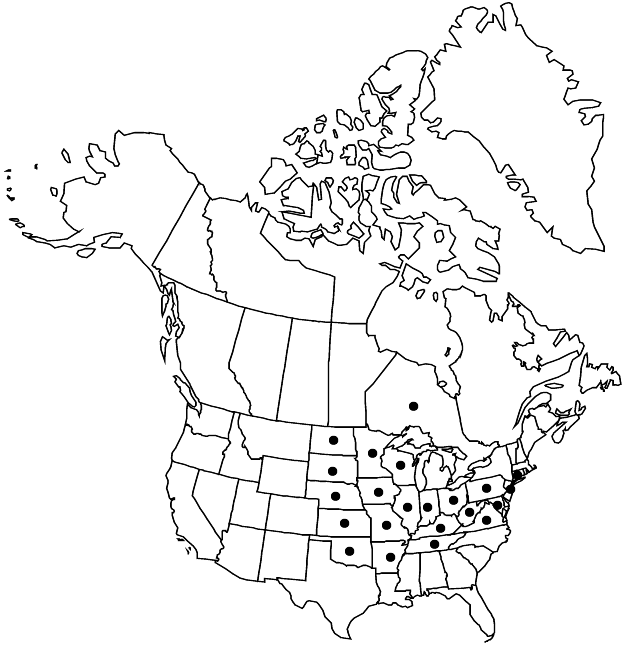Ribes missouriense
in J. Torrey and A. Gray, Fl. N. Amer. 1: 548. 1840 ,.
Plants 1.3–2 m. Stems erect to sprawling, glabrous or puberulent; spines at nodes sometimes absent or 1–3, 7–18 mm; prickles on internodes absent or scattered. Leaves: petiole 0.7–2 cm, hairy, with longer and often plumose hairs and elongated glands near base, short-stipitate glands absent; blade roundish, 3-lobed, cleft nearly to midrib, 1.7–3 cm, base broadly cuneate to rounded or subcordate, sometimes truncate, surfaces not glandular, villous-tomentose abaxially, puberulent to hirsute, glabrescent adaxially, lobes straight-sided to sometimes cuneate, margins toothed, apex rounded. Inflorescences pendent, solitary flowers or 2–4-flowered corymbs, 3–5 cm, axis glabrous or sparsely lanate to pilose and puberulent, sparingly stipitate-glandular, flowers evenly spaced. Pedicels not jointed, 5–13 mm, glabrous; bracts broadly ovate, 2–2.5 mm, ciliate. Flowers: hypanthium greenish white, narrowly tubular, 1.5–2.5 mm, glabrous; sepals not overlapping, spreading to reflexed, pale green to white, linear-oblong, 5–7 mm; petals connivent, erect, pale green to nearly white, becoming pink tinged, cuneate-obovate, not conspicuously revolute or inrolled, 2–3.5 mm; nectary disc not prominent; stamens 3–5 times as long as petals; filaments linear, 15 mm, glabrous; anthers cream to pale pink, oblong-sagittate, 2 mm, apex rounded; ovary glabrous; styles connate nearly 7/8 their lengths, 10–14 mm, glabrous. Berries palatable, red to purple, globose, 7–12 mm, glabrous. 2n = 16.
Phenology: Flowering Apr–Jun.
Habitat: Upland woods, thickets, prairie ravines, pastures
Elevation: 0-600 m
Distribution

Ont., Ark., Conn., Ill., Ind., Iowa, Kans., Ky., Md., Minn., Mo., Nebr., N.J., N.Dak., Ohio, Okla., Pa., S.Dak., Tenn., Va., W.Va., Wis.
Discussion
In Ribes missouriense and some other species (e.g., R. americanum, R. cynosbati, R. oxyacanthoides), the filaments are attached in a “pocket” of the anthers; the anthers have a sagittate appearance although the bases do not spread away from the main axis (A. F. Cholewa, pers. comm.).
In the Midwest, Ribes missouriense often is an indicator of woodlands that have experienced grazing pressure (G. Yatskievych, pers. comm.). The eastern North American populations in Connecticut, Maryland, New Jersey, Pennsylvania, Virginia, and West Virginia are probably escapes from cultivation.
Selected References
None.